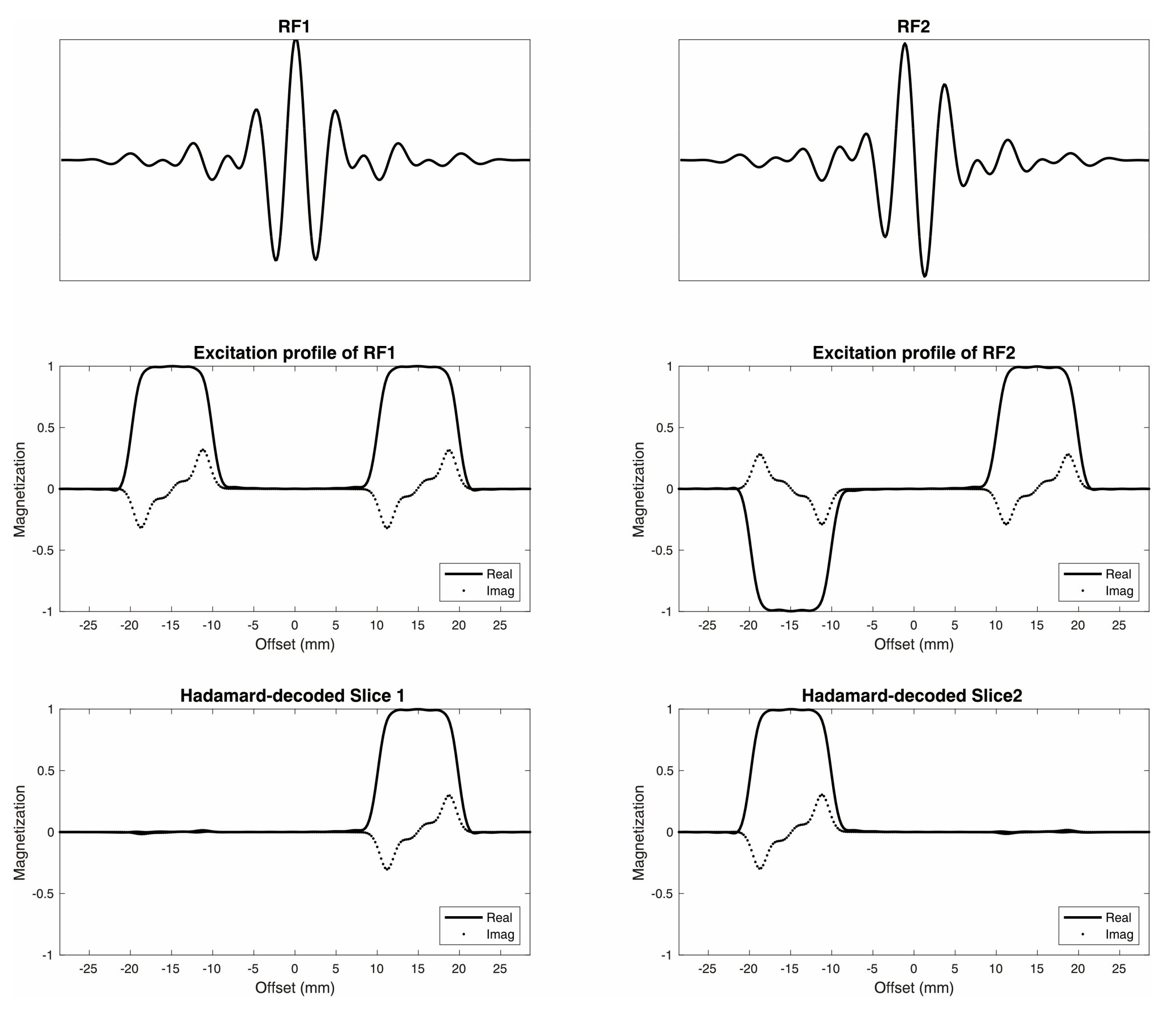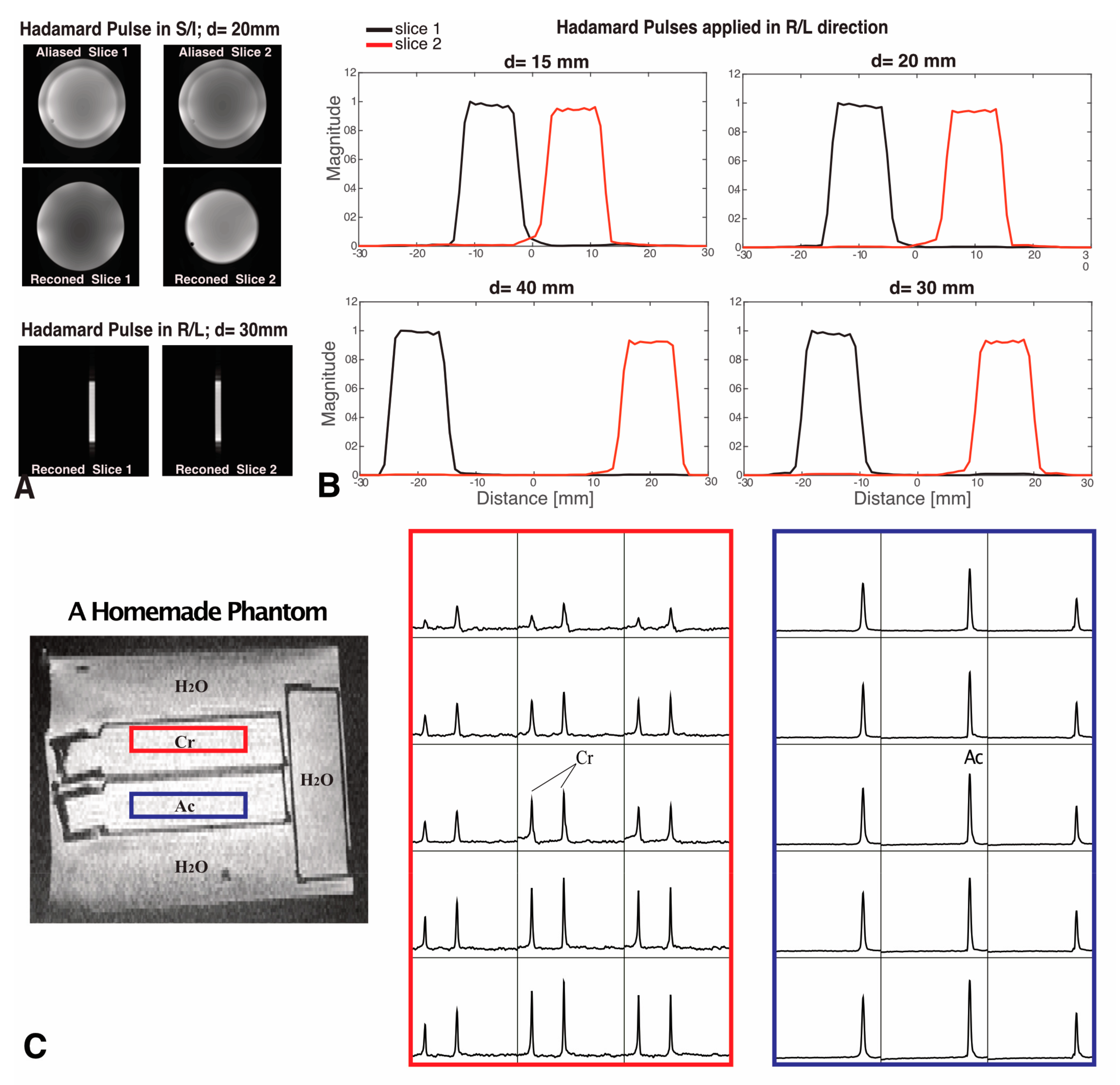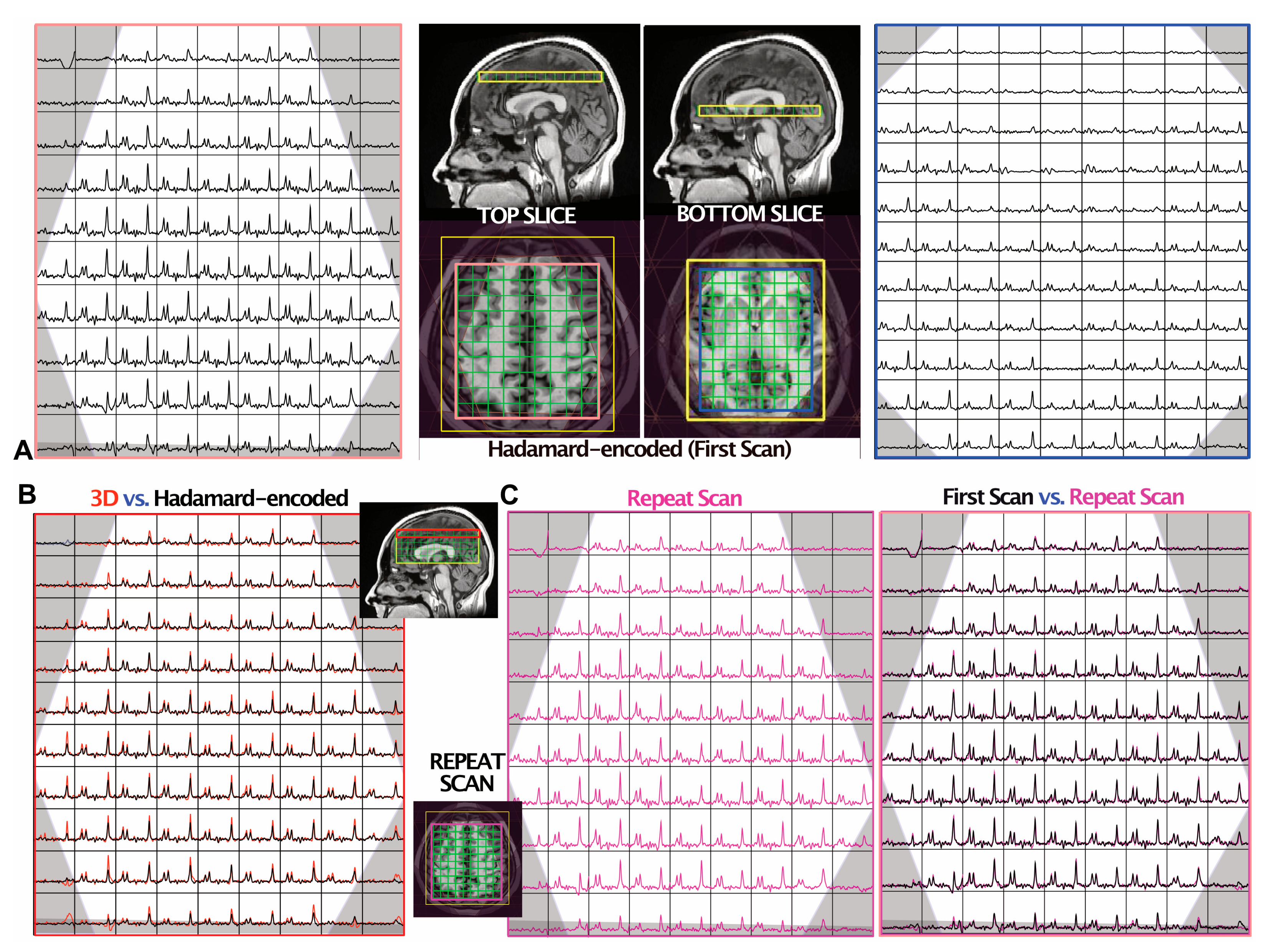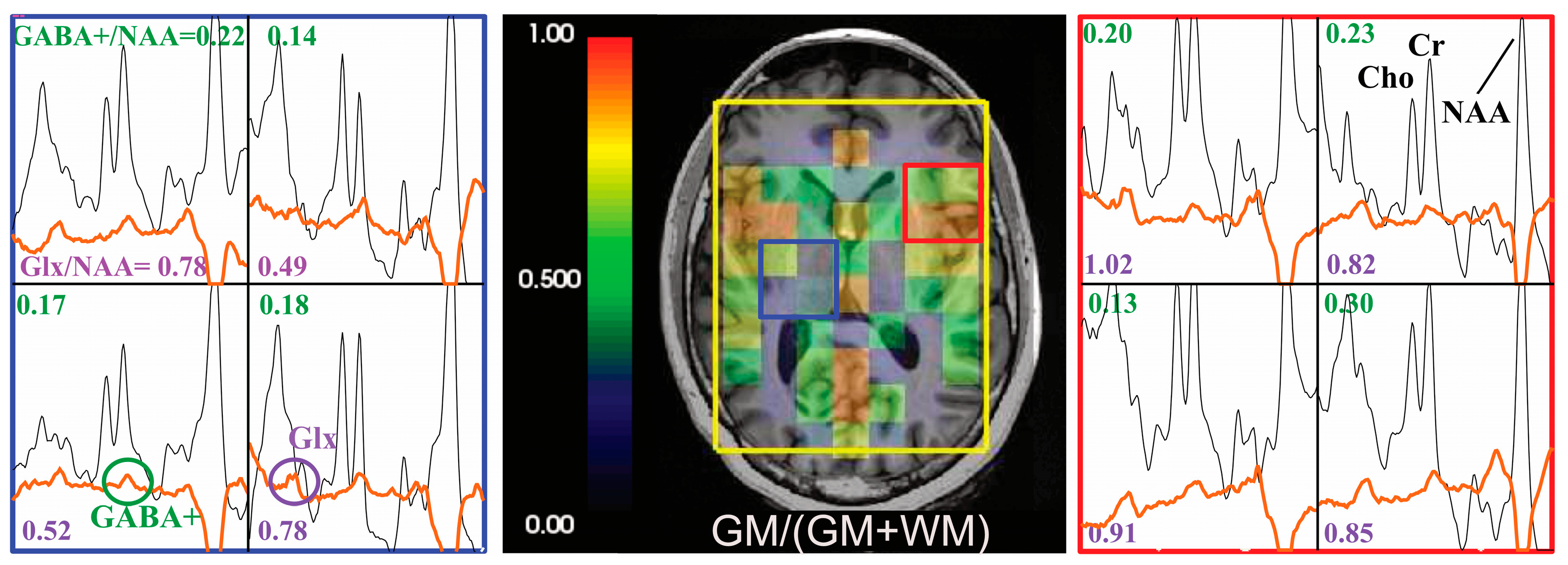Atlas-Based Adaptive Hadamard-Encoded MR Spectroscopic Imaging at 3T
Abstract
1. Introduction
2. Materials and Methods
2.1. Dual-Band Hadamard Pulse Simulation
2.2. MRSI Sequence
2.3. Phantom Imaging
2.4. In Vivo Imaging
2.5. Data Processing and Analysis
3. Results
3.1. Dual-Slice Localization Using Hadamard Encoding
3.2. SNR and Reproducibility of Simultaneous Dual-Slice MRSI
3.3. GABA-Edited Dual-Slice MRSI
4. Discussion
5. Conclusions
Author Contributions
Funding
Institutional Review Board Statement
Informed Consent Statement
Data Availability Statement
Conflicts of Interest
References
- Bertolino, A.; Callicott, J.H.; Nawroz, S.; Mattay, V.S.; Duyn, J.H.; Tedeschi, G.; Frank, J.A.; Weinberger, D.R. Reproducibility of proton magnetic resonance spectroscopic imaging in patients with schizophrenia. Neuropsychopharmacology 1998, 18, 1–9. [Google Scholar] [CrossRef]
- Tedeschi, G.; Bonavita, S.; Barton, N.W.; Betolino, A.; Frank, J.A.; Patronas, N.J.; Alger, J.R.; Schiffmann, R. Proton magnetic resonance spectroscopic imaging in the clinical evaluation of patients with Niemann-Pick type C disease. J. Neurol. Neurosurg. Psychiatry 1998, 65, 72–79. [Google Scholar] [CrossRef]
- Kurhanewicz, J.; Vigneron, D.B.; Nelson, S.J. Three-dimensional magnetic resonance spectroscopic imaging of brain and prostate cancer. Neoplasia 2000, 2, 166–189. [Google Scholar] [CrossRef]
- Zhu, H.; Barker, P.B. MR spectroscopy and spectroscopic imaging of the brain. Methods Mol. Biol. 2011, 711, 203–226. [Google Scholar] [CrossRef]
- Oz, G.; Alger, J.R.; Barker, P.B.; Bartha, R.; Bizzi, A.; Boesch, C.; Bolan, P.J.; Brindle, K.M.; Cudalbu, C.; Dincer, A.; et al. Clinical proton MR spectroscopy in central nervous system disorders. Radiology 2014, 270, 658–679. [Google Scholar] [CrossRef]
- Li, Y.; Jakary, A.; Gillung, E.; Eisendrath, S.; Nelson, S.J.; Mukherjee, P.; Luks, T. Evaluating metabolites in patients with major depressive disorder who received mindfulness-based cognitive therapy and healthy controls using short echo MRSI at 7 Tesla. MAGMA 2016, 29, 523–533. [Google Scholar] [CrossRef]
- Bogner, W.; Otazo, R.; Henning, A. Accelerated MR spectroscopic imaging-a review of current and emerging techniques. NMR Biomed. 2021, 34, e4314. [Google Scholar] [CrossRef]
- Nelson, S.J.; Ozhinsky, E.; Li, Y.; Park, I.; Crane, J. Strategies for rapid in vivo 1H and hyperpolarized 13C MR spectroscopic imaging. J. Magn. Reson. 2013, 229, 187–197. [Google Scholar] [CrossRef]
- Posse, S.; Tedeschi, G.; Risinger, R.; Ogg, R.; Le Bihan, D. High speed 1H spectroscopic imaging in human brain by echo planar spatial-spectral encoding. Magn. Reson. Med. 1995, 33, 34–40. [Google Scholar] [CrossRef]
- Cunningham, C.H.; Vigneron, D.B.; Chen, A.P.; Xu, D.; Nelson, S.J.; Hurd, R.E.; Kelley, D.A.; Pauly, J.M. Design of flyback echo-planar readout gradients for magnetic resonance spectroscopic imaging. Magn. Reson. Med. 2005, 54, 1286–1289. [Google Scholar] [CrossRef]
- Adalsteinsson, E.; Irarrazabal, P.; Topp, S.; Meyer, C.; Macovski, A.; Spielman, D.M. Volumetric spectroscopic imaging with spiral-based k-space trajectories. Magn. Reson. Med. 1998, 39, 889–898. [Google Scholar] [CrossRef] [PubMed]
- Furuyama, J.K.; Wilson, N.E.; Thomas, M.A. Spectroscopic imaging using concentrically circular echo-planar trajectories in vivo. Magn. Reson. Med. 2012, 67, 1515–1522. [Google Scholar] [CrossRef] [PubMed]
- Schirda, C.V.; Tanase, C.; Boada, F.E. Rosette spectroscopic imaging: Optimal parameters for alias-free, high sensitivity spectroscopic imaging. J. Magn. Reson. Imaging 2009, 29, 1375–1385. [Google Scholar] [CrossRef]
- Lin, F.H.; Tsai, S.Y.; Otazo, R.; Caprihan, A.; Wald, L.L.; Belliveau, J.W.; Posse, S. Sensitivity-encoded (SENSE) proton echo-planar spectroscopic imaging (PEPSI) in the human brain. Magn. Reson. Med. 2007, 57, 249–257. [Google Scholar] [CrossRef]
- Dydak, U.; Weiger, M.; Pruessmann, K.P.; Meier, D.; Boesiger, P. Sensitivity-encoded spectroscopic imaging. Magn. Reson. Med. 2001, 46, 713–722. [Google Scholar] [CrossRef] [PubMed]
- Ozturk-Isik, E.; Chen, A.P.; Crane, J.C.; Bian, W.; Xu, D.; Han, E.T.; Chang, S.M.; Vigneron, D.B.; Nelson, S.J. 3D sensitivity encoded ellipsoidal MR spectroscopic imaging of gliomas at 3T. Magn. Reson. Imaging 2009, 27, 1249–1257. [Google Scholar] [CrossRef] [PubMed][Green Version]
- Hamilton, J.; Franson, D.; Seiberlich, N. Recent advances in parallel imaging for MRI. Prog. Nucl. Magn. Reson. Spectrosc. 2017, 101, 71–95. [Google Scholar] [CrossRef] [PubMed]
- Boer, V.O.; Klomp, D.W.; Laterra, J.; Barker, P.B. Parallel reconstruction in accelerated multivoxel MR spectroscopy. Magn. Reson. Med. 2015, 74, 599–606. [Google Scholar] [CrossRef]
- Souza, S.P.; Szumowski, J.; Dumoulin, C.L.; Plewes, D.P.; Glover, G. SIMA: Simultaneous multislice acquisition of MR images by Hadamard-encoded excitation. J. Comput. Assist. Tomogr. 1988, 12, 1026–1030. [Google Scholar] [CrossRef]
- Cunningham, C.H.; Wood, M.L. Method for improved multiband excitation profiles using the Shinnar-Le Roux transform. Magn. Reson. Med. 1999, 42, 577–584. [Google Scholar] [CrossRef]
- Breuer, F.A.; Blaimer, M.; Heidemann, R.M.; Mueller, M.F.; Griswold, M.A.; Jakob, P.M. Controlled aliasing in parallel imaging results in higher acceleration (CAIPIRINHA) for multi-slice imaging. Magn. Reson. Med. 2005, 53, 684–691. [Google Scholar] [CrossRef]
- Goelman, G.; Liu, S.; Fleysher, R.; Fleysher, L.; Grossman, R.I.; Gonen, O. Chemical-shift artifact reduction in Hadamard-encoded MR spectroscopic imaging at high (3T and 7T) magnetic fields. Magn. Reson. Med. 2007, 58, 167–173. [Google Scholar] [CrossRef]
- Tal, A.; Goelman, G.; Gonen, O. In vivo free induction decay based 3D multivoxel longitudinal hadamard spectroscopic imaging in the human brain at 3 T. Magn. Reson. Med. 2013, 69, 903–911. [Google Scholar] [CrossRef][Green Version]
- Hangel, G.; Strasser, B.; Povazan, M.; Heckova, E.; Hingerl, L.; Boubela, R.; Gruber, S.; Trattnig, S.; Bogner, W. Ultra-high resolution brain metabolite mapping at 7 T by short-TR Hadamard-encoded FID-MRSI. Neuroimage 2018, 168, 199–210. [Google Scholar] [CrossRef]
- Setsompop, K.; Fan, Q.; Stockmann, J.; Bilgic, B.; Huang, S.; Cauley, S.F.; Nummenmaa, A.; Wang, F.; Rathi, Y.; Witzel, T.; et al. High-resolution in vivo diffusion imaging of the human brain with generalized slice dithered enhanced resolution: Simultaneous multislice (gSlider-SMS). Magn. Reson. Med. 2018, 79, 141–151. [Google Scholar] [CrossRef] [PubMed]
- Goelman, G.; Walter, G.; Leigh, J.S. Hadamard spectroscopic imaging technique as applied to study human calf muscles. Magn. Reson. Med. 1992, 25, 349–354. [Google Scholar] [CrossRef] [PubMed]
- Goelman, G. Fast Hadamard spectroscopic imaging techniques. J. Magn. Reson. B 1994, 104, 212–218. [Google Scholar] [CrossRef]
- Pruessmann, K.P.; Weiger, M.; Scheidegger, M.B.; Boesiger, P. SENSE: Sensitivity encoding for fast MRI. Magn. Reson. Med. 1999, 42, 952–962. [Google Scholar] [CrossRef]
- Ozturk-Isik, E.; Crane, J.C.; Cha, S.; Chang, S.M.; Berger, M.S.; Nelson, S.J. Unaliasing lipid contamination for MR spectroscopic imaging of gliomas at 3T using sensitivity encoding (SENSE). Magn. Reson. Med. 2006, 55, 1164–1169. [Google Scholar] [CrossRef] [PubMed]
- Bonekamp, D.; Smith, M.A.; Zhu, H.; Barker, P.B. Quantitative SENSE-MRSI of the human brain. Magn. Reson. Imaging 2010, 28, 305–313. [Google Scholar] [CrossRef]
- Sharma, K.R.; Saigal, G.; Maudsley, A.A.; Govind, V. 1H MRS of basal ganglia and thalamus in amyotrophic lateral sclerosis. NMR Biomed. 2011, 24, 1270–1276. [Google Scholar] [CrossRef]
- Wang, Y.; Li, X.; Chen, W.; Wang, Z.; Xu, Y.; Luo, J.; Lin, H.; Sun, G. Detecting neuronal dysfunction of hand motor cortex in ALS: A MRSI study. Somatosens. Mot. Res. 2017, 34, 15–20. [Google Scholar] [CrossRef] [PubMed][Green Version]
- Jang, J.H.; Kwon, J.S.; Jang, D.P.; Moon, W.J.; Lee, J.M.; Ha, T.H.; Chung, E.C.; Kim, I.Y.; Kim, S.I. A proton MRSI study of brain N-acetylaspartate level after 12 weeks of citalopram treatment in drug-naive patients with obsessive-compulsive disorder. Am. J. Psychiatry 2006, 163, 1202–1207. [Google Scholar] [CrossRef] [PubMed]
- Gaetz, W.; Bloy, L.; Wang, D.J.; Port, R.G.; Blaskey, L.; Levy, S.E.; Roberts, T.P. GABA estimation in the brains of children on the autism spectrum: Measurement precision and regional cortical variation. Neuroimage 2014, 86, 1–9. [Google Scholar] [CrossRef] [PubMed]
- Treiman, D.M. GABAergic mechanisms in epilepsy. Epilepsia 2001, 42 (Suppl. S3), 8–12. [Google Scholar] [CrossRef]
- Puts, N.A.; Edden, R.A. In vivo magnetic resonance spectroscopy of GABA: A methodological review. Prog. Nucl. Magn. Reson. Spectrosc. 2012, 60, 29–41. [Google Scholar] [CrossRef]
- Rowland, L.M.; Kontson, K.; West, J.; Edden, R.A.; Zhu, H.; Wijtenburg, S.A.; Holcomb, H.H.; Barker, P.B. In vivo measurements of glutamate, GABA, and NAAG in schizophrenia. Schizophr. Bull. 2013, 39, 1096–1104. [Google Scholar] [CrossRef] [PubMed]
- Taylor, S.F.; Tso, I.F. GABA abnormalities in schizophrenia: A methodological review of in vivo studies. Schizophr. Res. 2015, 167, 84–90. [Google Scholar] [CrossRef]
- Mescher, M.; Merkle, H.; Kirsch, J.; Garwood, M.; Gruetter, R. Simultaneous in vivo spectral editing and water suppression. NMR Biomed. 1998, 11, 266–272. [Google Scholar] [CrossRef]
- Mullins, P.G.; McGonigle, D.J.; O’Gorman, R.L.; Puts, N.A.; Vidyasagar, R.; Evans, C.J.; Cardiff Symposium on, M.R.S.o.G.; Edden, R.A. Current practice in the use of MEGA-PRESS spectroscopy for the detection of GABA. Neuroimage 2014, 86, 43–52. [Google Scholar] [CrossRef]
- Bogner, W.; Gagoski, B.; Hess, A.T.; Bhat, H.; Tisdall, M.D.; van der Kouwe, A.J.W.; Strasser, B.; Marjanska, M.; Trattnig, S.; Grant, E.; et al. 3D GABA imaging with real-time motion correction, shim update and reacquisition of adiabatic spiral MRSI. Neuroimage 2014, 103, 290–302. [Google Scholar] [CrossRef] [PubMed]
- Chan, K.L.; Oeltzschner, G.; Saleh, M.G.; Edden, R.A.E.; Barker, P.B. Simultaneous editing of GABA and GSH with Hadamard-encoded MR spectroscopic imaging. Magn. Reson. Med. 2019, 82, 21–32. [Google Scholar] [CrossRef] [PubMed]
- Ma, R.E.; Murdoch, J.B.; Bogner, W.; Andronesi, O.; Dydak, U. Atlas-based GABA mapping with 3D MEGA-MRSI: Cross-correlation to single-voxel MRS. NMR Biomed. 2020, 34, e4275. [Google Scholar] [CrossRef]
- Bian, W.; Li, Y.; Crane, J.C.; Nelson, S.J. Fully automated atlas-based method for prescribing 3D PRESS MR spectroscopic imaging: Toward robust and reproducible metabolite measurements in human brain. Magn. Reson. Med. 2018, 79, 636–642. [Google Scholar] [CrossRef] [PubMed]
- Shinnar, M.; Eleff, S.; Subramanian, H.; Leigh, J.S. The synthesis of pulse sequences yielding arbitrary magnetization vectors. Magn. Reson. Med. 1989, 12, 74–80. [Google Scholar] [CrossRef] [PubMed]
- Pauly, J.; Le Roux, P.; Nishimura, D.; Macovski, A. Parameter relations for the Shinnar-Le Roux selective excitation pulse design algorithm [NMR imaging]. IEEE Trans. Med. Imaging 1991, 10, 53–65. [Google Scholar] [CrossRef]
- Bloch, F. Nuclear Induction. Phys. Rev. 1946, 70, 460–474. [Google Scholar] [CrossRef]
- Li, Y.; Osorio, J.A.; Ozturk-Isik, E.; Chen, A.P.; Xu, D.; Crane, J.C.; Cha, S.; Chang, S.; Berger, M.S.; Vigneron, D.B.; et al. Considerations in applying 3D PRESS H-1 brain MRSI with an eight-channel phased-array coil at 3 T. Magn. Reson. Imaging 2006, 24, 1295–1302. [Google Scholar] [CrossRef]
- Star-Lack, J.; Nelson, S.J.; Kurhanewicz, J.; Huang, L.R.; Vigneron, D.B. Improved water and lipid suppression for 3D PRESS CSI using RF band selective inversion with gradient dephasing (BASING). Magn. Reson. Med. 1997, 38, 311–321. [Google Scholar] [CrossRef]
- Haase, A.; Frahm, J.; Hanicke, W.; Matthaei, D. 1H NMR chemical shift selective (CHESS) imaging. Phys. Med. Biol. 1985, 30, 341–344. [Google Scholar] [CrossRef]
- Li, Y.; Lafontaine, M.; Chang, S.; Nelson, S.J. Comparison between Short and Long Echo Time Magnetic Resonance Spectroscopic Imaging at 3T and 7T for Evaluating Brain Metabolites in Patients with Glioma. ACS Chem. Neurosci. 2018, 9, 130–137. [Google Scholar] [CrossRef] [PubMed]
- Crane, J.C.; Olson, M.P.; Nelson, S.J. SIVIC: Open-Source, Standards-Based Software for DICOM MR Spectroscopy Workflows. Int. J. Biomed. Imaging 2013, 2013, 169526. [Google Scholar] [CrossRef] [PubMed]
- Li, Y.; Bian, W.; Larson, P.; Crane, J.C.; Parvathaneni, P.; Nagarajan, S.; Nelson, S.J. Reliable and Reproducible GABA Measurements Using Automated Spectral Prescription at Ultra-High Field. Front. Hum. Neurosci. 2017, 11, 506. [Google Scholar] [CrossRef] [PubMed]
- Nelson, S.J. Analysis of volume MRI and MR spectroscopic imaging data for the evaluation of patients with brain tumors. Magn. Reson. Med. 2001, 46, 228–239. [Google Scholar] [CrossRef] [PubMed]
- Provencher, S.W. Automatic quantitation of localized in vivo 1H spectra with LCModel. NMR Biomed. 2001, 14, 260–264. [Google Scholar] [CrossRef]
- Govindaraju, V.; Young, K.; Maudsley, A.A. Proton NMR chemical shifts and coupling constants for brain metabolites. NMR Biomed. 2000, 13, 129–153. [Google Scholar] [CrossRef]
- Starcuk, Z., Jr.; Starcukova, J. Quantum-mechanical simulations for in vivo MR spectroscopy: Principles and possibilities demonstrated with the program NMRScopeB. Anal. Biochem. 2017, 529, 79–97. [Google Scholar] [CrossRef]
- Stefan, D.; Di Cesare, F.; Andrasescu, A.; Popa, E.; Lazariev, A.; Vescovo, E.; Strbak, O.; Williams, S.; Starcuk, Z.; Cabanas, M.; et al. Quantitation of magnetic resonance spectroscopy signals: The jMRUI software package. Meas. Sci. Technol. 2009, 20, 104035. [Google Scholar] [CrossRef]
- Zhang, Y.; Brady, M.; Smith, S. Segmentation of brain MR images through a hidden Markov random field model and the expectation-maximization algorithm. IEEE Trans. Med. Imaging 2001, 20, 45–57. [Google Scholar] [CrossRef]
- Hancu, I.; Blezek, D.J.; Dumoulin, M.C. Automatic repositioning of single voxels in longitudinal 1H MRS studies. NMR Biomed. 2005, 18, 352–361. [Google Scholar] [CrossRef]
- Ratai, E.M.; Hancu, I.; Blezek, D.J.; Turk, K.W.; Halpern, E.; Gonzalez, R.G. Automatic repositioning of MRSI voxels in longitudinal studies: Impact on reproducibility of metabolite concentration measurements. J. Magn. Reson. Imaging 2008, 27, 1188–1193. [Google Scholar] [CrossRef] [PubMed]
- Yung, K.T.; Zheng, W.; Zhao, C.; Martinez-Ramon, M.; van der Kouwe, A.; Posse, S. Atlas-based automated positioning of outer volume suppression slices in short-echo time 3D MR spectroscopic imaging of the human brain. Magn. Reson. Med. 2011, 66, 911–922. [Google Scholar] [CrossRef]
- Ozhinsky, E.; Vigneron, D.B.; Chang, S.M.; Nelson, S.J. Automated prescription of oblique brain 3D magnetic resonance spectroscopic imaging. Magn. Reson. Med. 2013, 69, 920–930. [Google Scholar] [CrossRef]
- Park, Y.W.; Deelchand, D.K.; Joers, J.M.; Hanna, B.; Berrington, A.; Gillen, J.S.; Kantarci, K.; Soher, B.J.; Barker, P.B.; Park, H.; et al. AutoVOI: Real-time automatic prescription of volume-of-interest for single voxel spectroscopy. Magn. Reson. Med. 2018, 80, 1787–1798. [Google Scholar] [CrossRef]
- Moser, P.; Hingerl, L.; Strasser, B.; Povazan, M.; Hangel, G.; Andronesi, O.C.; van der Kouwe, A.; Gruber, S.; Trattnig, S.; Bogner, W. Whole-slice mapping of GABA and GABA(+) at 7T via adiabatic MEGA-editing, real-time instability correction, and concentric circle readout. Neuroimage 2019, 184, 475–489. [Google Scholar] [CrossRef]
- Scheenen, T.W.; Heerschap, A.; Klomp, D.W. Towards 1H-MRSI of the human brain at 7T with slice-selective adiabatic refocusing pulses. MAGMA 2008, 21, 95–101. [Google Scholar] [CrossRef] [PubMed]
- Tal, A.; Zhao, T.; Schirda, C.; Hetherington, H.P.; Pan, J.W.; Gonen, O. Fast, regional three-dimensional hybrid (1D-Hadamard 2D-rosette) proton MR spectroscopic imaging in the human temporal lobes. NMR Biomed. 2021, 34, e4507. [Google Scholar] [CrossRef] [PubMed]




| Location | GABA+/NAA | GABA+/Cr | GABA+ CRLB | NAA CRLB | Cr CRLB | |
|---|---|---|---|---|---|---|
| Top slice | GM | 0.16 ± 0.02 | 0.21 ± 0.02 | 16 ± 2 | 2 ± 0.3 | 3 ± 0.4 |
| WM | 0.14 ± 0.02 | 0.22 ± 0.03 | 16 ± 2 | 2 ± 0.2 | 3 ± 0.2 | |
| Bottom slice | GM | 0.18 ± 0.02 | 0.21 ± 0.04 | 13 ± 5 | 2 ± 0.2 | 3 ± 0.4 |
| WM | 0.16 ± 0.02 | 0.23 ± 0.04 | 15 ± 2 | 2 ± 0.3 | 3 ± 0.4 | |
Disclaimer/Publisher’s Note: The statements, opinions and data contained in all publications are solely those of the individual author(s) and contributor(s) and not of MDPI and/or the editor(s). MDPI and/or the editor(s) disclaim responsibility for any injury to people or property resulting from any ideas, methods, instructions or products referred to in the content. |
© 2023 by the authors. Licensee MDPI, Basel, Switzerland. This article is an open access article distributed under the terms and conditions of the Creative Commons Attribution (CC BY) license (https://creativecommons.org/licenses/by/4.0/).
Share and Cite
Liu, H.; Autry, A.W.; Larson, P.E.Z.; Xu, D.; Li, Y. Atlas-Based Adaptive Hadamard-Encoded MR Spectroscopic Imaging at 3T. Tomography 2023, 9, 1592-1602. https://doi.org/10.3390/tomography9050127
Liu H, Autry AW, Larson PEZ, Xu D, Li Y. Atlas-Based Adaptive Hadamard-Encoded MR Spectroscopic Imaging at 3T. Tomography. 2023; 9(5):1592-1602. https://doi.org/10.3390/tomography9050127
Chicago/Turabian StyleLiu, Huawei, Adam W. Autry, Peder E. Z. Larson, Duan Xu, and Yan Li. 2023. "Atlas-Based Adaptive Hadamard-Encoded MR Spectroscopic Imaging at 3T" Tomography 9, no. 5: 1592-1602. https://doi.org/10.3390/tomography9050127
APA StyleLiu, H., Autry, A. W., Larson, P. E. Z., Xu, D., & Li, Y. (2023). Atlas-Based Adaptive Hadamard-Encoded MR Spectroscopic Imaging at 3T. Tomography, 9(5), 1592-1602. https://doi.org/10.3390/tomography9050127






